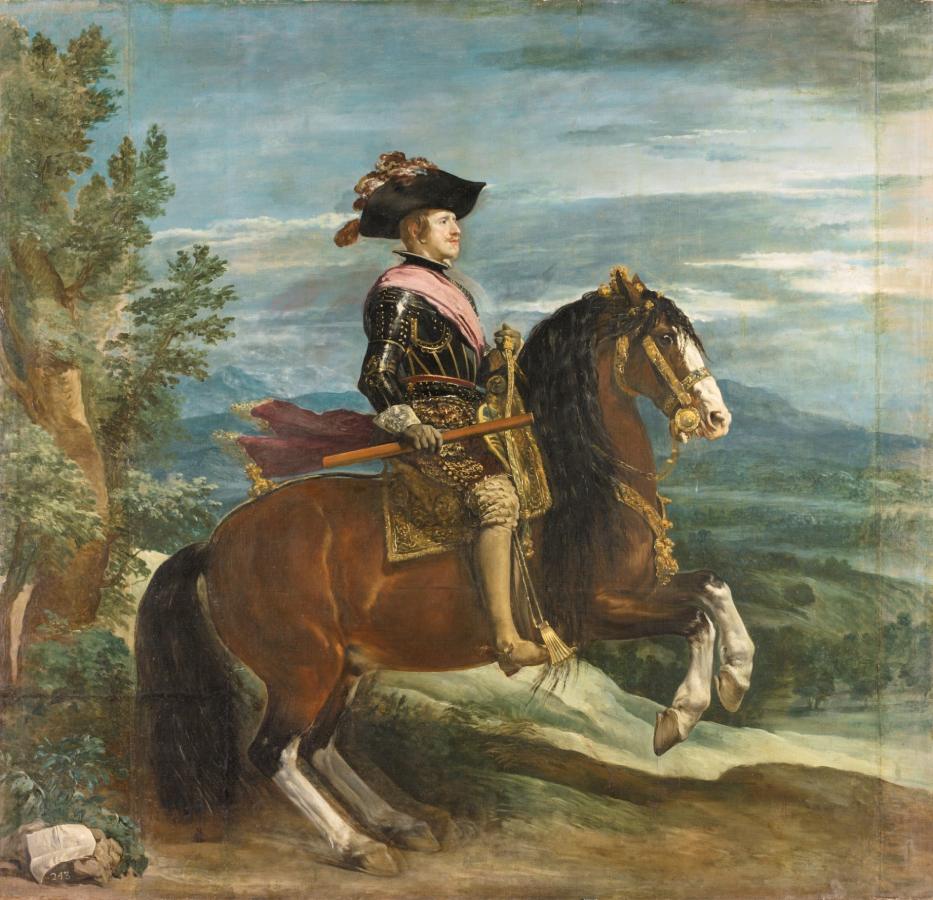Velázquez, Diego (1599-1660)
Felipe IV, a caballo (Philip IV on horseback)
c.1635
Oil on canvas, 303 x 317 cm
Museo del Prado, Madrid
Of the equestrian portraits painted for the Hall of Realms, this is the only one with a declaration of authorship. The lower left corner has been a customary place throughout the history of painting for the artist’s signature, and here it bears a sheet of paper. And yet, contrary to our expectations, it is blank. This is the painter’s way of telling the viewer that the originality of his style and the quality of his technique are more than sufficient to affirm his authorship. Velázquez used this method on other occasions, including The Surrender of Breda (P01172) and the equestrian portrait of Gaspar de Guzmán, Count-Duke of Olivares (P01181). But in a series with such complex origins and authorships as this set of equestrian portraits, it takes on a special meaning as, here, the artist takes responsibility for the entire canvas. This is unquestionably the most important work of the group and it is a masterpiece in its genre. In keeping with the decidedly martial character of the Hall of Realms, the present work emphasizes the monarch’s military responsibilities. Like his father (P01176), Philip IV is depicted on a rearing horse, carrying a baton and wearing armor and a sash, all of which imbue the image with a sense of authority and firmness. Nevertheless, besides the very notable contrast in pictorial quality, this work differs subtly from the likeness of his father. The setting has changed. Rather than the marine background in the portrait of Philip III or the landscaped garden behind Margarita de Austria (P01177), the present work is set in an open landscape with a broad horizon over irregular terrain that closely resembles the foothills between Madrid and the Guadarrama -especially the area around the Sierra del Hoyo-, with its wooded meadows and undergrowth. This was a familiar setting for Velázquez, and it recalls the background in his Portrait of Prince Baltasar Carlos on Horseback (P01180) -although the latter had much more specific topographical references- as well as some portraits of buffoons and hunters, including Philip IV in Hunting Garb (P01184). Moreover, while Philip III is presented in a foreshortened view that brings dynamism and pomp to his image, his son appears here in rigorous profile. This perspective, and the fact that the king looks straight forward, rather than directly at the viewer, as his father did, brings a sense of serenity and majesty to this canvas. Equestrian portraits frequently used their iconographic and compositional resources to create images in which the idea of command is transmitted through violence, movement and energy. Here, however, Velázquez emphasizes the tranquility of power. The image itself is rooted in Titian‘s portrait of the Emperor Charles V at Mühlberg (P00410), which was one of the most appreciated paintings in the Royal Collections. The two works have multiple similarities that affect both their composition and content. In each, a tree runs the entire height of the canvas on the left, framing the figures placed before an open landscape with an ample horizon that gives the sky an outstanding role. Also, both emphasize the tranquility and majesty of the protagonist, who knows how to rein in his mount. As the likeness of the reigning monarch, the present work was the most carefully crafted and significant of the group and its content is subtly linked to two of the most important battle scenes. Both The Recovery of Bahia in 1664 (P00885) and The Surrender of Breda (P01172) offer very precise images of the Spanish monarchy as a strong institution that wields power in a fair and magnanimous fashion. And power, justice and magnanimity are perfectly depicted in the image of Philip IV that Velázquez generates here. There has been considerable speculation about when, and under what circumstances this work was painted, which is true of all six of the works that Velázquez created for the Hall of Realms, and for which he received various payments between August 1634 and June 1635. (Museo Nacional del Prado, El Palacio del Rey Planeta: Felipe IV y el Buen Retiro, Madrid, Museo Nacional del Prado, 2005, p.116)
See also:
• Felipe IV, King of Spain (1605-1665)
